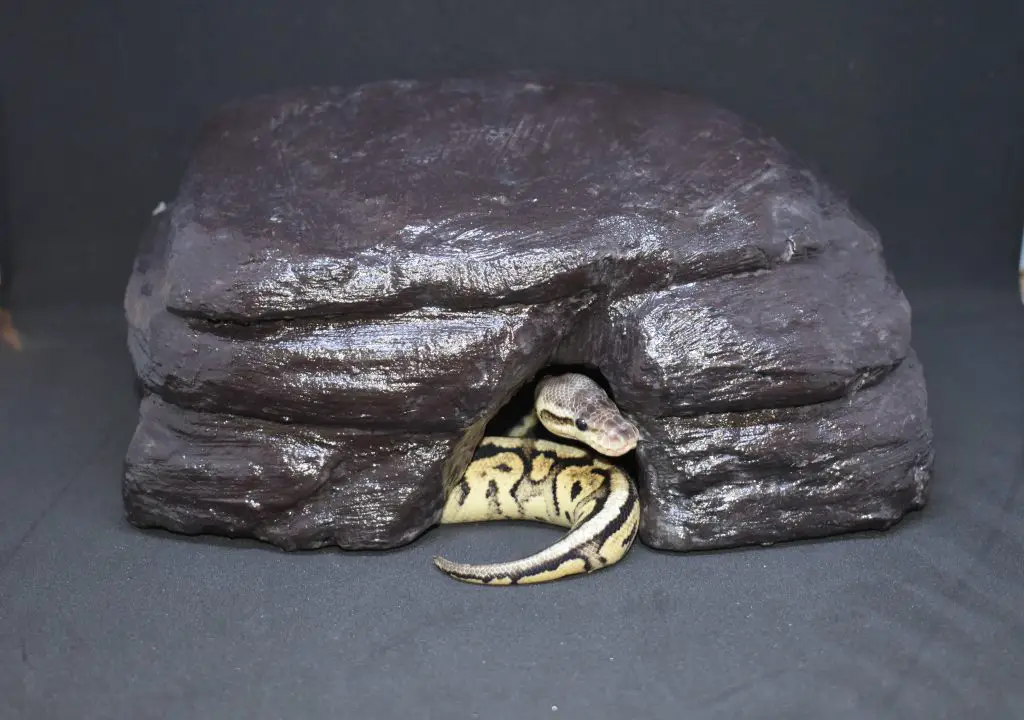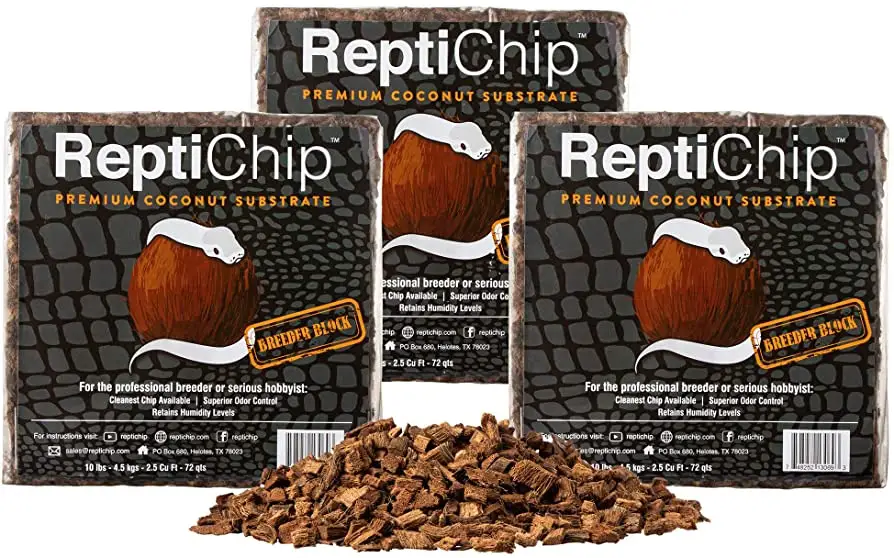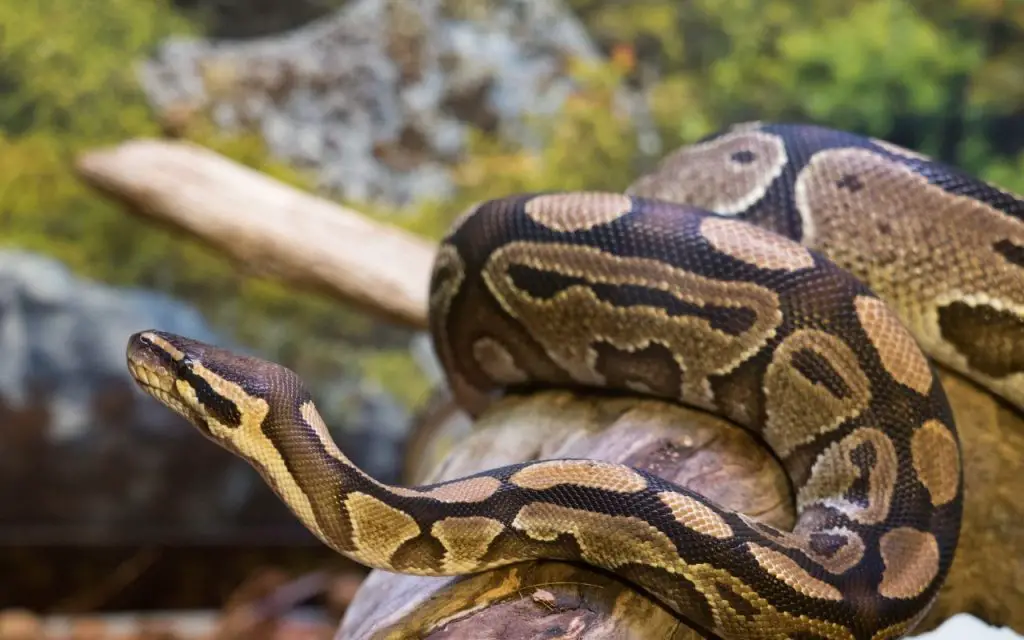Ball Python substrate and hiding places are vital aspects of any enclosure. Substrate plays a big role in maintaining the correct levels of humidity. Hiding places, on the other hand, have two roles. First, they make your snake feel safe, and this in turn makes them more likely to eat. Second, they give it additional places to explore.
In this article, we’ll take a look at how to choose both hides and substrate, before providing you with a couple more in-depth posts on each subject…
The importance of hiding places
It’s a well-known fact that pythons, including Ball Pythons and others use refugia to help them survive. By refugia, I mean appropriate hiding places. For small species like the Ball Python, this generally means very snug hiding places. Let me explain why…
Of major importance for Ball Pythons is the security aspect. These animals are what is called positively thigmotactic (i.e. seek contact with objects/substrate for security), and must have a hiding place that is dark, sturdy and they fit into snugly. In a rack system the drawer itself provides the “hide”, but if you opt for a vivarium or large plastic tub then you need to provide at least two hides: one in the cool end and one in the warm end.
This way, your snake can thermoregulate by moving from one hide to the other, without remaining exposed. Personally, I like the Exo Terra caves because they are heavy enough for adults and now come in an XXL size that is large enough for most females. I have included a link to these on the Ball Python Products page. Occasionally, you will encounter a female that is too big for these hides, in which case using a log or constructing a hideout of cork bark is a good idea. You can also buy black plastic hides that are a bit flimsy, but still better than nothing.

Homemade hides
A word of caution on mold-proof products! Mold-proofing is the in-thing right for coolers, paints, foam insulation – heck, anything that could in theory get damp at some point.
The problem with this is that mold inhibiting chemicals often seem to attack all forms of ectothermic or poikilothermic life. Over time, they release something known as Volatile Organic Compounds (VOCs).
If you use them on cool homemade hides for your snakes, chances are they will slowly poison them. So far, I’ve known two breeders who have had whole clutches killed by anti-mold linings in their incubators!
If you make hides for your snakes, check and double-every material you use. Especially any paints, varnishes, or self-hardening foams.

Substrate
As far as substrates go, the most popular options are aspen shavings, newspaper, orchid bark, coconut fibre, cypress mulch and paper towels. Newspaper and paper towels are cheap and absorbent. They also make it easy to clean out the enclosure completely and ensure correct levels of hygiene. Although it looks similar to paper towels, I do know of a python that had an allergic reaction to toilet paper, so this is best avoided!
A lot of people use newspaper or paper towels for the above reasons, but there’s nothing wrong with cypress mulch, orchid bark and coconut fibre. In fact, they are great for maintaining humidity. Personally, I don’t like aspen chips, but I have spoken to people with larger collections than me that swear by it.
Your best bet is to choose a substrate that makes it easy to maintain humidity and that you can afford to change regularly. Recently, coco husk has become extremely trendy, but personally, I find it way too susceptible to mould. I don’t particularly care what’s trendy, or what other people use – and neither should you. Try some substrates and find the one that suits your setup.
All-in-all, the safest options for substrate include:
- Cypress mulch
- Newspaper
- Orhcid bark
- Coco chips
- Coco coir (not my favorite, but safe)
- Paper mulch (Lignocel)
- Aspen chips (not shavings)

Options to avoid
When choosing a substrate, bear in mind that Cedar, and to a lesser extent pine, are toxic to snakes and should never be used. Sand also appears to be harmful, being regularly inhaled and ingested by Ball Pythons if used. Whilst it is true that sand tends to block the digestive system of species that haven’t evolved to deal with it, don’t worry if your snake accidentally swallows a chunk of a different type of substrate – this happens all the time in nature with no ill effects.
Unsafe and possibly fatal substrate choices:
- Cedar
- Pine
- Unsterilised soil
- Sand
- Scented paper towels or toilet paper (can cause allergic reactions)
Decorations
Ball Pythons go through life getting progressively lazier as they get heavier. For example, a 2000 gram+ female won’t need a lot of high branches to climb on. A young snake on the other hand might explore, climb, check, and double-check every nook and cranny of its enclosure every night.
Males tend to be a little more active, but generally it’s just a sign they want some food. Some males will always climb, but again most of them stop being that interested once they reach a certain age, or once they have a full belly.
So how do you decorate an enclosure for a slow, methodical explorer like a Ball Python? The key is to keep the branches low as to avoid falls, and to add variety to the floor of the enclosure.
Giving your snake low obstacles to climb over and explore is the best way to enrich their nightly exploring activities. You can use branches, fake plants, additional hiding places and even cardboard tubes to add texture to the enclosure.

More on this subject:
Ball Python Care topics:
- Intro
- Enclosure guidelines
- Bedding and refugia *You are here
- Heat and Light
- Humidity, water, and shedding
- Ball Python Size
- Handling
- Diet
- Health and hygiene
- Breeding
- Eggs
